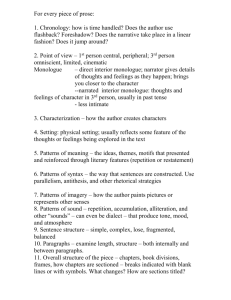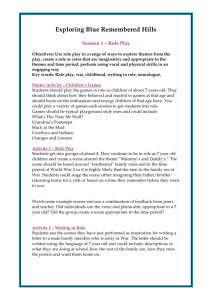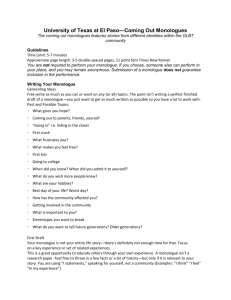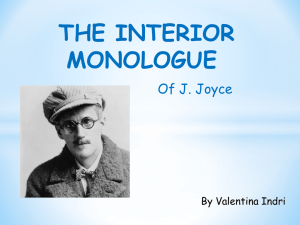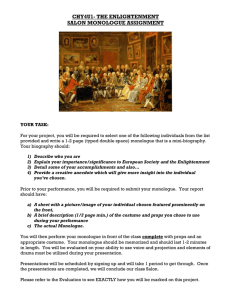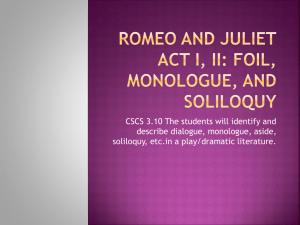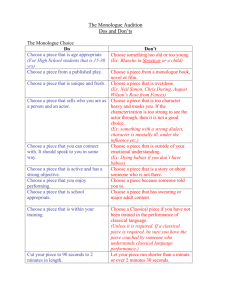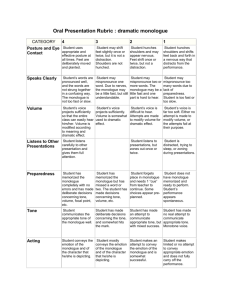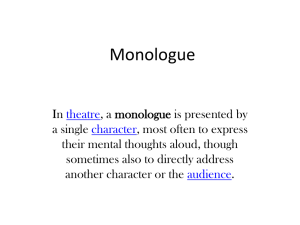monologue planner
advertisement
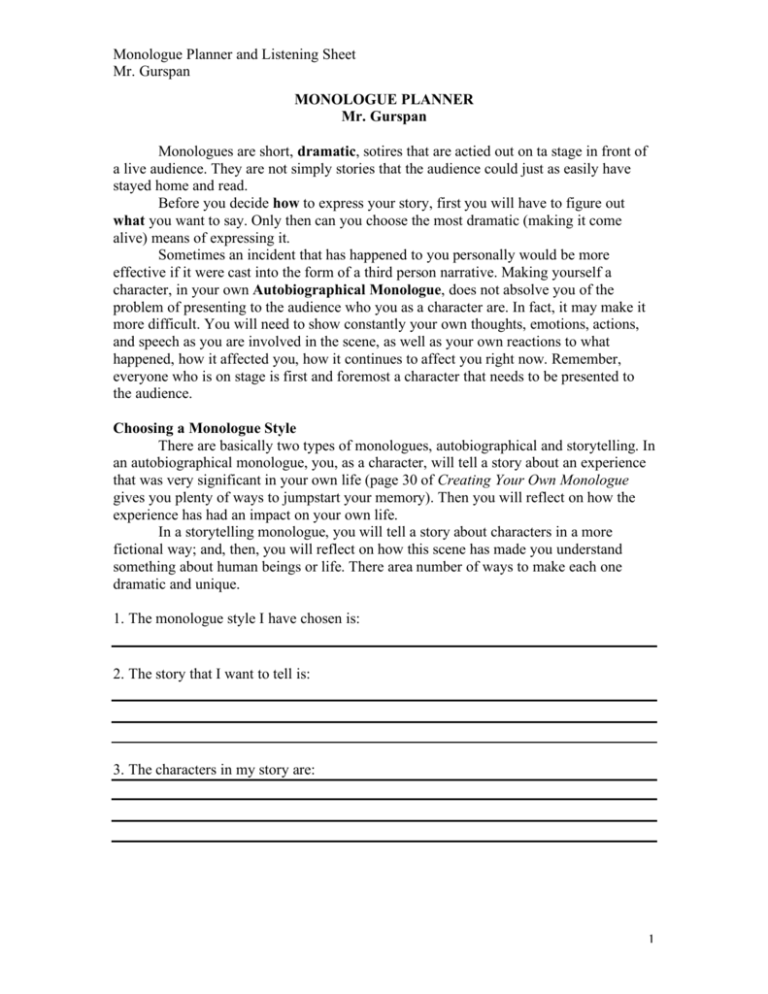
Monologue Planner and Listening Sheet Mr. Gurspan MONOLOGUE PLANNER Mr. Gurspan Monologues are short, dramatic, sotires that are actied out on ta stage in front of a live audience. They are not simply stories that the audience could just as easily have stayed home and read. Before you decide how to express your story, first you will have to figure out what you want to say. Only then can you choose the most dramatic (making it come alive) means of expressing it. Sometimes an incident that has happened to you personally would be more effective if it were cast into the form of a third person narrative. Making yourself a character, in your own Autobiographical Monologue, does not absolve you of the problem of presenting to the audience who you as a character are. In fact, it may make it more difficult. You will need to show constantly your own thoughts, emotions, actions, and speech as you are involved in the scene, as well as your own reactions to what happened, how it affected you, how it continues to affect you right now. Remember, everyone who is on stage is first and foremost a character that needs to be presented to the audience. Choosing a Monologue Style There are basically two types of monologues, autobiographical and storytelling. In an autobiographical monologue, you, as a character, will tell a story about an experience that was very significant in your own life (page 30 of Creating Your Own Monologue gives you plenty of ways to jumpstart your memory). Then you will reflect on how the experience has had an impact on your own life. In a storytelling monologue, you will tell a story about characters in a more fictional way; and, then, you will reflect on how this scene has made you understand something about human beings or life. There area number of ways to make each one dramatic and unique. 1. The monologue style I have chosen is: 2. The story that I want to tell is: 3. The characters in my story are: 1 Monologue Planner and Listening Sheet Mr. Gurspan Objective or Goal The main character of your story, even if it is you, must have an objective or goal that she is trying or hoping to achieve, something that she feels that she must have. This is called the character’s motivation. This goal could something simple and tangible as, “My character really needs money for…” Or it could be something more abstract and invisible like, “My character really wants her mother to love her, or the respect of her friends.” Whatever objective you choose should be easily apparent to the audience. The audience must see your character struggling to achieve some goal in the middle section of your monologue. By the end of the monologue, she will either receive or not what she is trying to get. And this outcome will help to lead into the reaction part of your monologue. My main character is trying hard to: There should also be an obstacle that is preventing the character from achieving her goal, either something external like another person or society, or something internal like her own fears and inhibitions. Either way the audience needs to see the struggle that the character is going through to achieve her goal. The obstacle that is preventing my character from achieving her goal is: How does the character struggle with the obstacle to achieve her goal? Each struggle has a resolution. Either the character achieves the goal or she does not, or there is no compromise. The arc of the monologue, from the beginning, through the middle, to the end is the journey that your character takes to get what she needs. How does your story end? 2 Monologue Planner and Listening Sheet Mr. Gurspan Now for the conclusion of the monologue, you as the speaker will show some reaction to the story that you have just told. Again, this could be long or short, personal or philosophical. But, you must step outside of the story that you have been telling and address the audience or another character on stage. My reaction to the story that I told is: Every monologue is addressed or spoken to someone. It is imperative for believability that the audience knows who the actor on stage is speaking to at all times, especially if the focus of your monologue changes. Are you speaking to an invisible character like a friend, while the café people and the audience overhear you? Is it the audience directly? Is it the people in the café? Is it yourself trying to debate a problem for which you are working out a solution? Is it someone in the monologue? Is it a combination of any of the above? You need to make this known explicitly in your monologue, by saying, “mom,” “honey,” etc. Who are you speaking to in this monologue? Now that you know what you will be speaking about in your monologue and to whom you will be speaking, you need to decide how you will say your monologue. This is called the TONE of the piece. Is it in your face preaching, like a rap (this would probably be delivered directly to the audience)? Is it confrontational, bringing up a difficult topic with someone? Is it introspective, to yourself or a close friend? Are you confronting a demon in your life, in a challenging tone of voice? Maybe you are detached and observing some strange incident in life. The tone could also be hyper, involved, acting out a scene with lots of dialog, taking different parts of the story. The tone that I will use is (this should change during the monologue): 3 Monologue Planner and Listening Sheet Mr. Gurspan Each monologue begins because of a specific spark to ignite it. You nee to determine what the specific impetus is for you to express yourself so dramatically right here and right now. Are you provoked by an incident that happens in the café right now? Do you come into the café with something already on your mind? Do you have a story that you just must tell to a specific character in the café? Is she someone whom you already know? Do you have a profound insight that you must share with the world, i.e. the audience? Is there a certain group of people that you must talk to? Whatever spark ignites your monologue, there must be an immediate, urgent necessity for you to speak, in monologue form, that provokes you right now. The specific reason that I am speaking is: Where will you deliver your monologue? Sitting at a table? Walking around the café? Moving to the semi-built stage? A combination of all three? You need to block out each of your movements on the monologue sheet. While I speak, I will: MONOLOGUE FORMAT Introduction (engagement of audience) Beginning of story Middle of story End of story Reaction (to the story) 4 Monologue Planner and Listening Sheet Mr. Gurspan MONOLOGUE LISTENING SHEET Mr. Gurspan Actor: _____________________________________________________ What happens in the beginning of the story? What happens in the middle section (main section)? What is happens at the end of the story? What is the main character trying to do? What is preventing her from doing it? Who is the monologist speaking to? What tone of voice is being used? Or should be used? What suggestions do you have? 5
